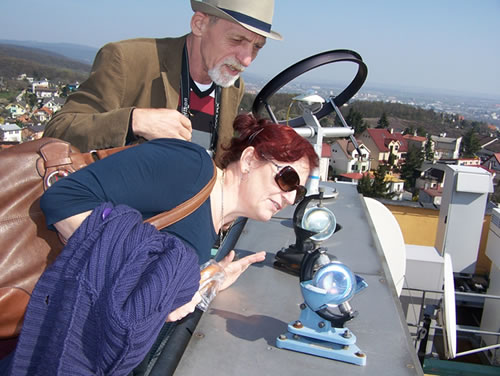
Open Door Day at the Slovak Hydrometeorological Institute in Bratislava
'International Water Day', 23 March, is a day celebrated by hydrologists around the world, and 24 March is the ‘Day of Meteorologists.’ This fortunate coincidence provides an annual opportunity for us at the Slovak Hydro-meteorological Institute to open our gates to the general public. And, vice-versa, for the public it provides an opportunity to meet those people who research and present information about various environmental phenomena.

On March 22 this year, almost 3,000 curious visitors made the most of this unique opportunity. And it was well worth their effort. They received a lot of information from the various work stations at the Slovak Hydro-meteorological Institute and took part in practical exercises. These exercises asked fundamental questions and illustrated perfectly the great diversity of the Institute’s activities:
-
Weather forecasts: How a weather forecast is created? What models are used and how does a supercomputer help with the calculations? Why do we watch the weather so closely? For who are the forecasts issued? How are they made suitable for TV broadcasting?
-
Hydrological forecasts: How do we know when a flood is imminent? What does it mean when a flood alert is issued? What does the Institute do during a flood? Why is the water content in snow measured? What is special about flood forecasting?
-
Meteorological services: These include: Climatological and meteorological observation networks; the processing and analysis of measurements; the Earth’s climatic system; national monitoring networks for assessing atmospheric quality; smog alert systems; the National Emissions Information System, which includes the recording of greenhouse gas emissions; radiation monitoring.
-
Hydrological services. These include information on the following: How water levels in rivers and creeks are measured. How the amount of underground water is measured. The country’s hydrological network. Available sources of drinking water. Data on water quality. What wildlife lives in our rivers?
-
Laboratory experimentation. The chemical and physical analyses of atmospheric samples and precipitation.
Although radiation monitoring is only one of the many interesting activities carried out at the Institute, during the Open Door Day it was one of the most visited work stations. Its history began back in 1963, when the department for monitoring of atmospheric radioactivity due to nuclear tests was established. At present, the system is one part of the State’s system of environmental monitoring and also serves as a means of providing timely warning against high radiation levels. The system contributes to the European Union’s Radiation Data Exchange Platform (EURDEP), and bilateral exchange of information with neighbouring countries – Hungary, Austria and the Czech Republic – goes on as well.
Visitors, however, did not limit their interest solely to radiation monitoring carried out by meteorological measurement stations, but also showed great interest in broader scenarios and discussed a range of issues associated with ionizing radiation. These included topics such as nuclear power plants and their safety, how to get energy from other sources and their respective environmental impacts, and radiation exposure from medical applications. But the most frequently questioned issue was that of radon in the environment and in the home, as well as possible ways of reducing it.
Visitors during the Open Door Day also appreciated the open and transparent approach of the Institute’s experts, who were able to inform them about their work in an interesting way, combining enthusiasm with a high level of expertise.
Tereza Melicherová
An expert in radiation monitoring at the Slovak Hydro-meteorological Institute in Bratislava, and a member of the Slovak Nuclear Society.
|

